
Here you can study for the exam. Look up keywords and learn definitions about all kind of subjects.
Roller inline hockey, or inline hockey is a variant of hockey played on a hard, smooth surface, with players using inline skates to move and hockey sticks to shoot a hard, plastic puck into their opponent's goal to score points. The sport is a very fast-paced and free-flowing game and is considered a contact sport, but body checking is prohibited. There are five players including the goalkeeper from each team on the rink at a time, while teams normally consist of 16 players. There are professional leagues, one of which is the National Roller Hockey League (NRHL). While it is not a contact sport, there are exceptions, i.e. the NRHL involves fighting. Unlike ice hockey, there are no blue lines or defensive zones in roller hockey. This means that, according to most rule codes, there are no offsides or icings that can occur during game play. This along with fewer players on the rink allows for faster gameplay. There are traditionally two 20-minute periods or four 10-minute periods with a stopped clock. (Source: Wikipedia.org, CC BY-SA)
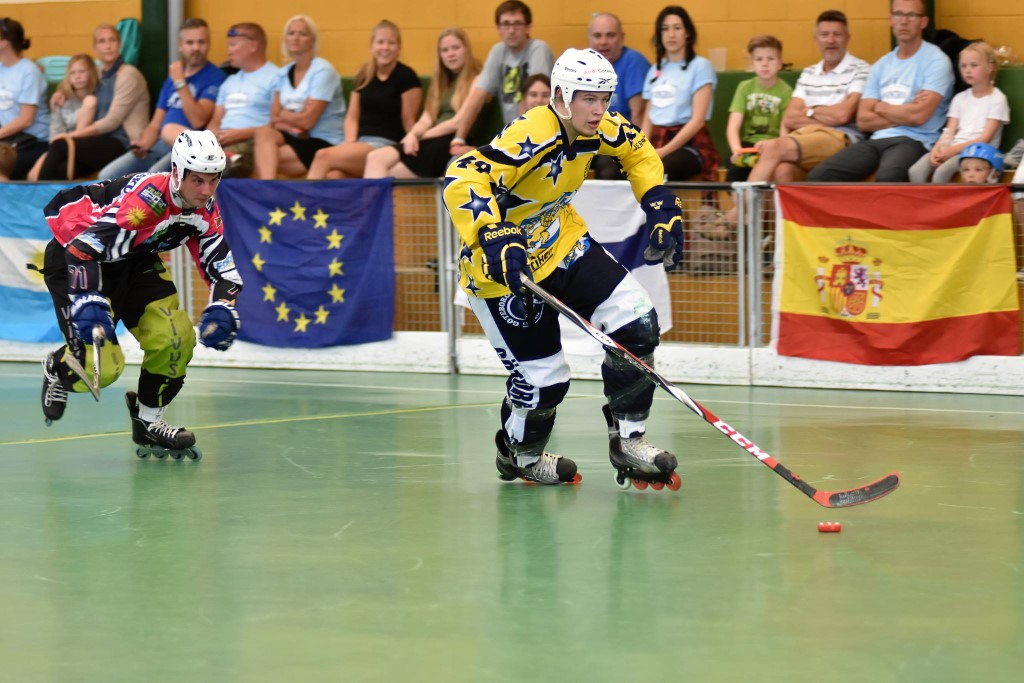 © Wikimedia.org/Lions Fuengirola Inline, CC BY
© Wikimedia.org/Lions Fuengirola Inline, CC BY
The javelin throw is a track and field event where the javelin, a spear about 2.5 m (8 ft 2 in) in length, is thrown. The javelin thrower gains momentum by running within a predetermined area. Javelin throwing is an event of both the men's decathlon and the women's heptathlon. The size, shape, minimum weight, and center of gravity of the javelin are all defined by IAAF rules. In international competition, men throw a javelin between 2.6 and 2.7 m (8 ft 6 in and 8 ft 10 in) in length and 800 g (28 oz) in weight, and women throw a javelin between 2.2 and 2.3 m (7 ft 3 in and 7 ft 7 in) in length and 600 g (21 oz) in weight. The javelin has a grip, about 150 mm (5.9 in) wide, made of cord and located at the javelin's center of gravity (0.9 to 1.06 m (2 ft 11 in to 3 ft 6 in)) from the javelin tip for the men's javelin and 0.8 to 0.92 m (2 ft 7 in to 3 ft 0 in) from the javelin tip for the women's javelin. (Source: Wikipedia.org, CC BY-SA)
Juggling is a physical skill, performed by a juggler, involving the manipulation of objects for recreation, entertainment, art or sport. The most recognizable form of juggling is toss juggling. Juggling can be the manipulation of one object or many objects at the same time, most often using one or two hands but also possible with feet. Jugglers often refer to the objects they juggle as props. The most common props are balls, clubs, or rings. Some jugglers use more dramatic objects such as knives, fire torches or chainsaws. The term juggling can also commonly refer to other prop-based manipulation skills, such as diabolo, plate spinning, devil sticks, poi, cigar boxes, contact juggling, hooping, yo-yo, and hat manipulation. (Source: Wikipedia.org, CC BY-SA)
Show jumping, is a part of a group of English riding equestrian events that also includes dressage, eventing, hunters, and equitation. Jumping classes are commonly seen at horse shows throughout the world, including the Olympics. Sometimes shows are limited exclusively to jumpers, sometimes jumper classes are offered in conjunction with other English-style events, and sometimes show jumping is but one division of very large, all-breed competitions that include a very wide variety of disciplines. Jumping classes may be governed by various national horse show sanctioning organizations, such as the United States Equestrian Federation in the USA or the British Showjumping Association in Great Britain. International competitions are governed by the rules of the International Federation for Equestrian Sports (FEI, from the body's French name of Fédération Équestre Internationale). Horses are very well-known for jumping in competition or even freely. (Source: Wikipedia.org, CC BY-SA)
Karate (空手) (/kəˈrɑːti/; Japanese pronunciation: [kaɾate] ; Okinawan pronunciation: [kaɽati]) is a martial art developed in the Ryukyu Kingdom. It developed from the indigenous Ryukyuan martial arts (called te (手), 'hand'; tii in Okinawan) under the influence of Chinese martial arts, particularly Fujian White Crane. Karate is now predominantly a striking art using punching, kicking, knee strikes, elbow strikes and open-hand techniques such as knife-hands, spear-hands and palm-heel strikes. Historically, and in some modern styles, grappling, throws, joint locks, restraints and vital-point strikes are also taught. A karate practitioner is called a karateka (空手家). (Source: Wikipedia.org, CC BY-SA)
Kart racing or karting is a road racing variant of motorsport with open-wheel, four-wheeled vehicles known as go-karts or shifter karts. They are usually raced on scaled-down circuits, although some professional kart races are also held on full-size motorsport circuits. Karting is commonly perceived as the stepping stone to the higher ranks of motorsports, with most of Formula One champions including Sebastian Vettel, Nico Rosberg, Ayrton Senna, Max Verstappen, Lewis Hamilton, Michael Schumacher, Kimi Räikkönen, and Fernando Alonso having begun their careers in karting. Karts vary widely in speed and some (known as superkarts) can reach speeds exceeding 161 kilometres per hour (100 mph), while recreational go-karts intended for the general public may be limited to lower speeds. (Source: Wikipedia.org, CC BY-SA)
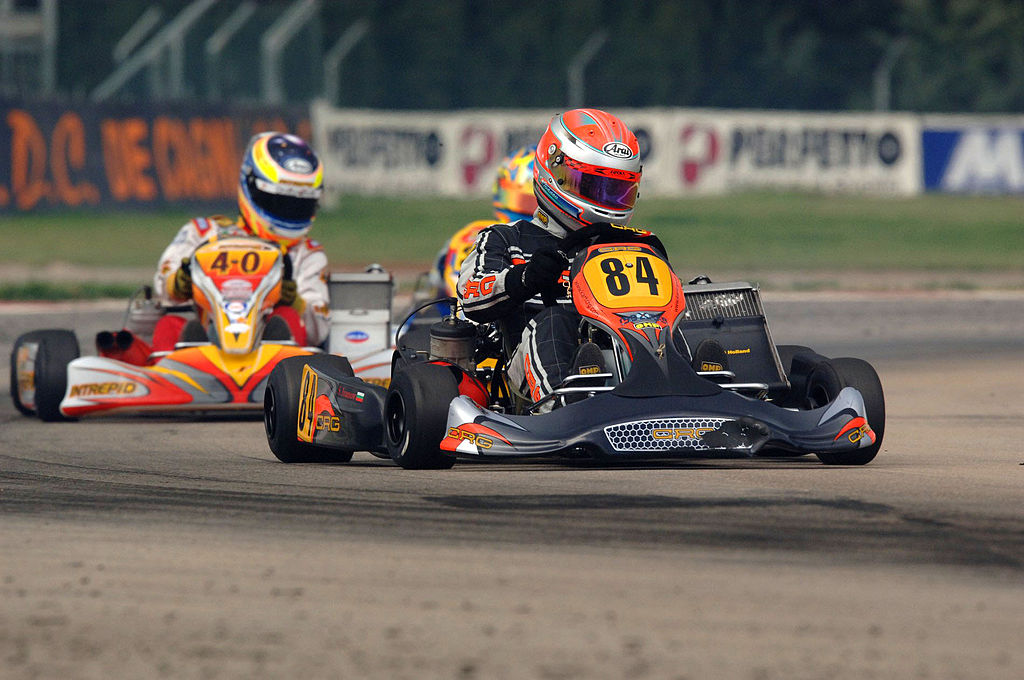 © Wikimedia.org/Speedracing, CC BY-SA
© Wikimedia.org/Speedracing, CC BY-SA
Kayaking is the use of a kayak for moving over water. It is distinguished from canoeing by the sitting position of the paddler and the number of blades on the paddle. A kayak is a low-to-the-water, canoe-like boat in which the paddler sits facing forward, legs in front, using a double-bladed paddle to pull front-to-back on one side and then the other in rotation. Most kayaks have closed decks, although sit-on-top and inflatable kayaks are growing in popularity as well. (Source: Wikipedia.org, CC BY-SA)
 © Wikimedia.org/Hillebrand Steve, CC0
© Wikimedia.org/Hillebrand Steve, CC0
Kickboxing is a combat sport focused on kicking and punching. The combat takes place in a boxing ring, normally with boxing gloves, mouthguards, shorts, and bare feet to favour the use of kicks. Kickboxing is practiced for self-defense, general fitness, or for competition. Some styles of kickboxing include: Karate, Muay Thai, Japanese kickboxing, Sanda, and Savate. (Source: Wikipedia.org, CC BY-SA)
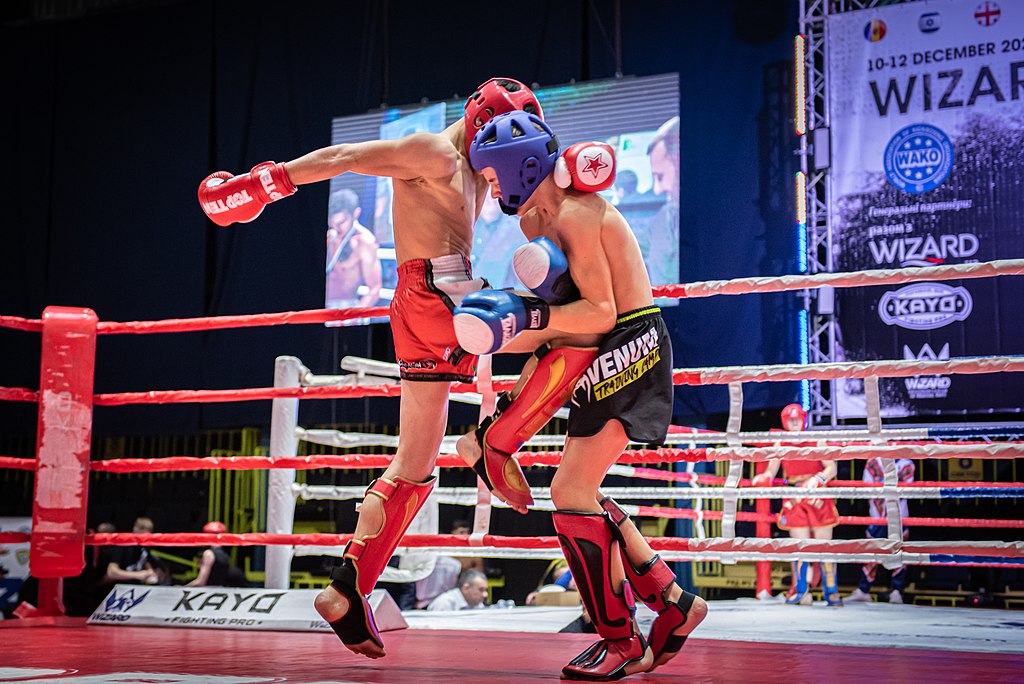 © Wikimedia.org/Bovvladua, CC BY-SA
© Wikimedia.org/Bovvladua, CC BY-SA
Kin-Ball, is a team sport created in Quebec, Canada in 1986 by Mario Demers, a physical education professor, in which the main distinctive characteristics are the large size of the ball (1.2m (48 inches) in diameter) and that the matches are played by three teams at the same time. The International Kin-Ball Federation counts 3.8 million participants, primarily from Canada, the U.S., Japan, Belgium, France, Switzerland, Spain, Germany, Denmark, the Czech Republic, Malaysia and China (including Hong Kong). The newest country is the UK; Kin-Ball UK formed in 2018. (Source: Wikipedia.org, CC BY-SA)
Kiteboarding or kitesurfing is a sport that involves using wind power with a large power kite to pull a rider across a water, land, or snow surface. It combines aspects of paragliding, surfing, windsurfing, skateboarding, snowboarding, and wakeboarding. Kiteboarding is among the less expensive and the more convenient sailing sports. After some concepts emerged in the late 1970s and early 1980s and some designs were successfully tested, the sport received a wider audience in the late 1990s and became mainstream at the turn of the century. It has freestyle, wave-riding, and racing competitions. The sport held the speed sailing record, reaching 55.65 kn (103.06 km/h) before being eclipsed by the 65.45 kn (121.21 km/h) Vestas Sailrocket. Worldwide, there are 1.5 million kitesurfers, while the industry sells around 100,000 to 150,000 kites per year. (Source: Wikipedia.org, CC BY-SA)
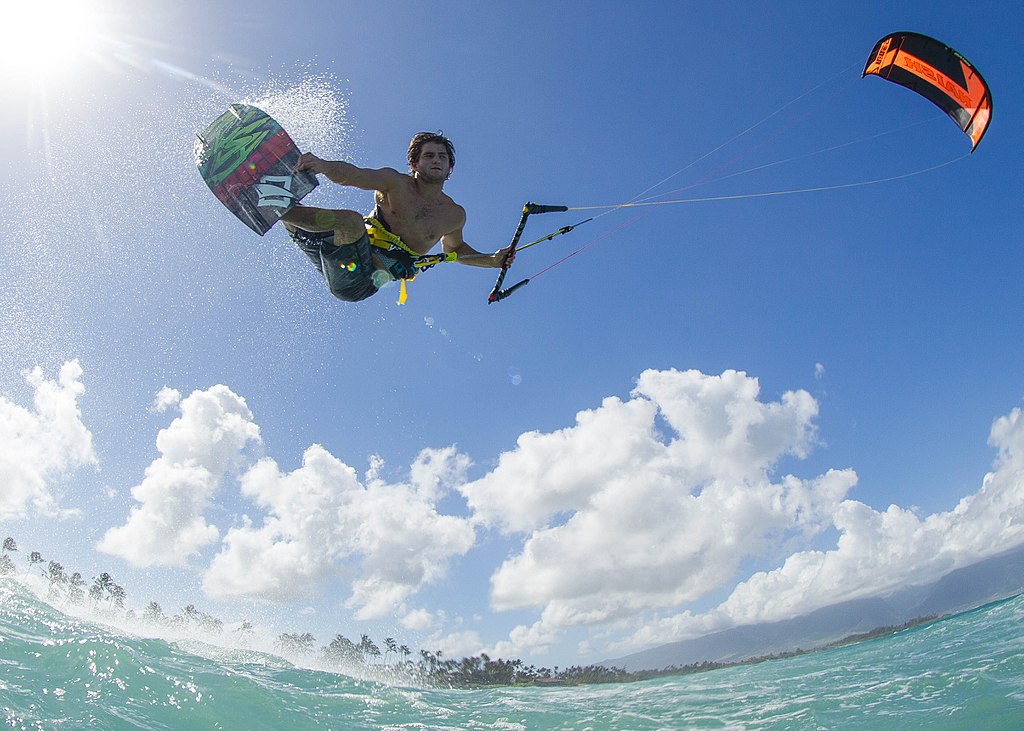 © Wikimedia.org/MakenaStockMedia, CC BY-SA
© Wikimedia.org/MakenaStockMedia, CC BY-SA
Korfball (Dutch: korfbal) is a ball sport, with similarities to netball and basketball. It is played by two teams of eight players with four female players and four male players in each team. The objective is to throw a ball into a netless basket that is mounted on a 3.5 m (11.5 feet) high pole. The sport was invented by Dutch school teacher Nico Broekhuysen in 1902. In the Netherlands there are approximately 500 clubs and more than 90,000 people playing korfball. The sport is also played in Belgium and Taiwan, and in nearly 70 other countries. (Source: Wikipedia.org, CC BY-SA)
Kubb (pronounced [kubː] in Swedish and Gutnish) is a lawn game where the objective is to knock over wooden blocks (kubbar) by throwing wooden batons (kastpinnar) at them. Kubb can be described as a combination of bowling and horseshoes. Play takes place on a small rectangular playing field, known as a 'pitch'. 'Kubbs' are placed at both ends of the pitch, and the 'king', a larger wooden block, is placed in the middle of the pitch. Some rules vary from country to country and from region to region, but the ultimate objective of the game is to knock over the 'kubbs' on the opposing side of the pitch, and then to knock over the 'king', before the opponent does. Games can last from five minutes to well over an hour. The game can be played on a variety of surfaces such as grass, sand, concrete, snow, or even ice. (Source: Wikipedia.org, CC BY-SA)
Lacrosse is a team sport played with a lacrosse stick and a lacrosse ball. It is the oldest organized sport in North America, with its origins with the indigenous people of North America as early as the 12th century. The game was extensively modified by European colonists, reducing the violence, to create its current collegiate and professional form. Players use the head of the lacrosse stick to carry, pass, catch, and shoot the ball into the goal. The sport has four versions that have different sticks, fields, rules and equipment: field lacrosse, women's lacrosse, box lacrosse and intercrosse. The men's games, field lacrosse (outdoor) and box lacrosse (indoor), are contact sports and all players wear protective gear: helmet, gloves, shoulder pads, and elbow pads. The women's game is played outdoors and does not allow body contact but does allow stick to stick contact. The only protective gear required for women players is eyegear, while goalies wear helmets and protective pads. Both men's and women's field lacrosse have 6v6 versions played on smaller fields, gaining acceptance in multi-sport events. Intercrosse is a mixed-gender non-contact sport played indoors that uses an all-plastic stick and a softer ball. (Source: Wikipedia.org, CC BY-SA)
Logrolling is the trading of favors, or quid pro quo, such as vote trading by legislative members to obtain passage of actions of interest to each legislative member. In organizational analysis, it refers to a practice in which different organizations promote each other's agendas, each in the expectation that the other will reciprocate. In an academic context, the Nuttall Encyclopedia describes logrolling as 'mutual praise by authors of each other's work'. Where intricate tactics or strategy are involved, the process may be called horse trading. (Source: Wikipedia.org, CC BY-SA)
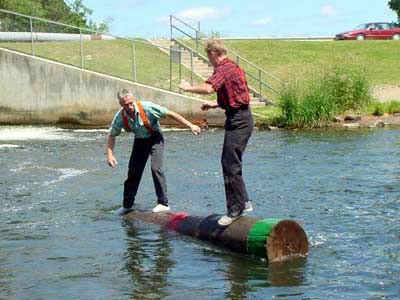 © Wikimedia.org/John Wetrosky, CC0
© Wikimedia.org/John Wetrosky, CC0
The long jump is a track and field event in which athletes combine speed, strength and agility in an attempt to leap as far as possible from a takeoff point. Along with the triple jump, the two events that measure jumping for distance as a group are referred to as the 'horizontal jumps'. This event has a history in the ancient Olympic Games and has been a modern Olympic event for men since the first Olympics in 1896 and for women since 1948. (Source: Wikipedia.org, CC BY-SA)
Longboarding is typically defined as a variation of skateboarding that involves a larger than usual board and softer urethane wheels. Longboards vary in shape and size. Compared to skateboards, longboards are more stable at speed and have more traction, due to larger wheel size and lower wheel durometers. A standard skateboard is typically between 28-34 inches long, whereas a longboard may exceed upwards of 50 inches long. Modern downhill race boards however are typically between 30-35 inches in length, making them more comparable to the length of a traditional skateboard. Many longboards use trucks that have different geometric parameters than skateboards. The skateboards use 'traditional kingpin trucks' while longboards often use 'reverse kingpin trucks.' This hardware change is the key element in the increased stability that longboards offer. The term 'longboarding' encapsulates multiple disciplines of riding. These include downhill, freeride, freestyle, dance and long-distance-push. (Source: Wikipedia.org, CC BY-SA)
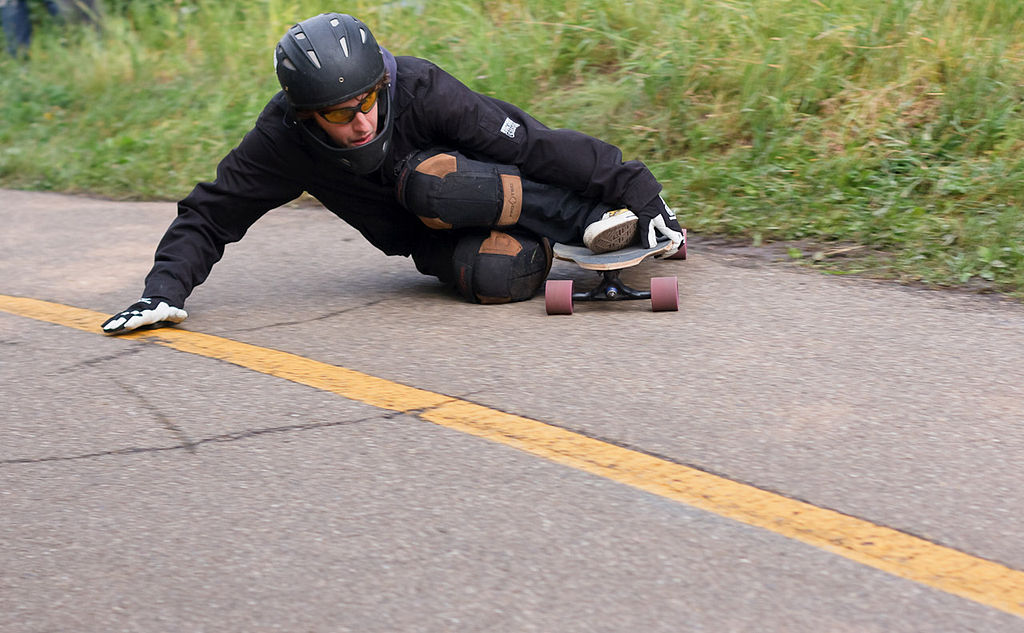 © Wikimedia.org/Trevorhall89, CC BY-SA
© Wikimedia.org/Trevorhall89, CC BY-SA
Match crossbow is a target shooting sport using crossbows. Unlike field crossbow, match crossbow is quite similar to the Olympic rifle. The International Crossbow Shooting Union (Internationale Armbrustschutzen Union-IAU) is the world governing body of crossbow target shooting. Founded 24. June 1956 in Landshut, Germany, the IAU supervises World and Continental crossbow championships in the two disciplines 10 m and 30 m Match. World Championships take place every two years, with Continental Championships on intervening years. Other International and IAU-Cup events take place annually. (Source: Wikipedia.org, CC BY-SA)
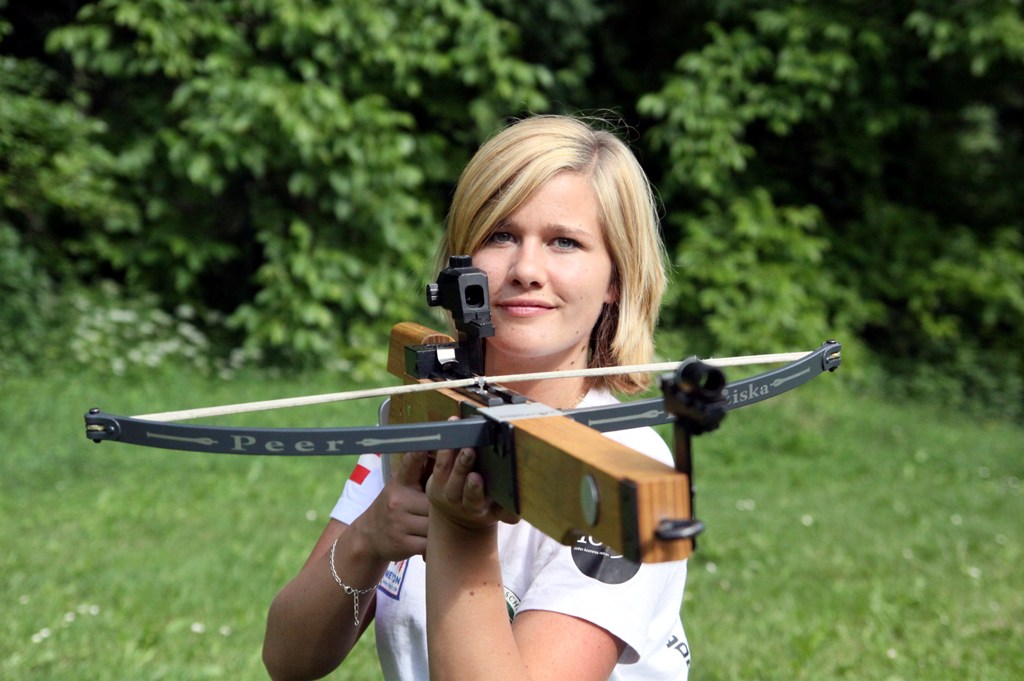 © Wikimedia.org/Markus Bichler, CC BY-SA
© Wikimedia.org/Markus Bichler, CC BY-SA
Miniature golf, also known as minigolf, mini-putt, crazy golf, or putt-putt, is an offshoot of the sport of golf focusing solely on the putting aspect of its parent game. The aim of the game is to score the lowest number of points. It is played on courses consisting of a series of holes (usually a multiple of 9) similar to its parent, but characterized by their short length (usually within 10 yards from tee to cup). The game uses artificial putting surfaces (such as carpet, artificial turf, or concrete), a geometric layout often requiring non-traditional putting lines such as bank shots, and artificial obstacles such as tunnels, tubes, ramps, moving obstacles such as windmills, and walls of concrete, metal, or fiberglass. When miniature golf retains many of these characteristics but without the use of any props or obstacles, it is purely a mini version of its parent game. (Source: Wikipedia.org, CC BY-SA)
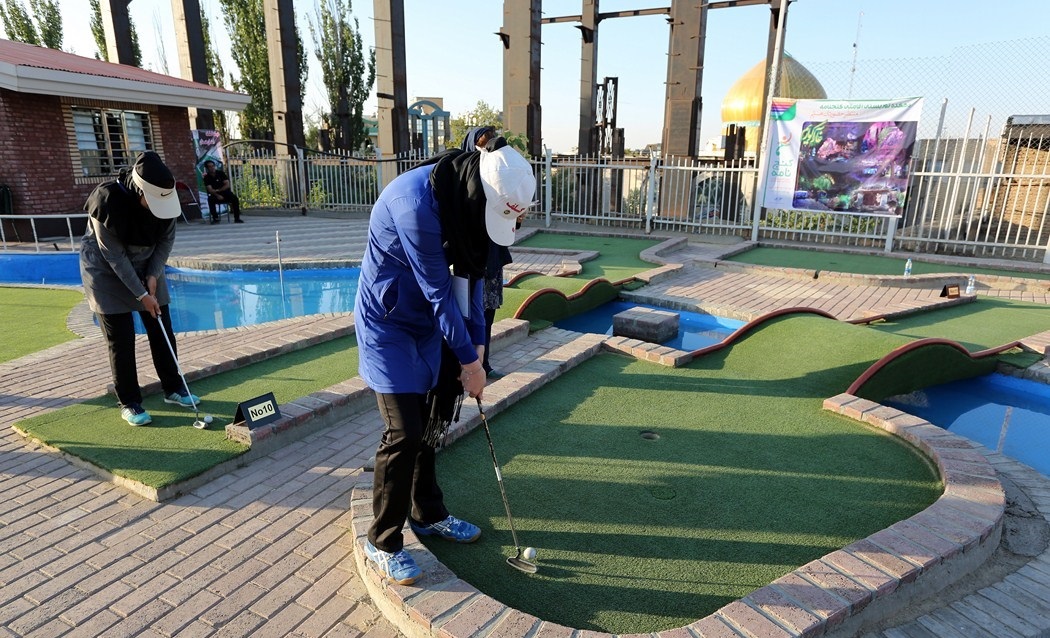 © Wikimedia.org/Fars Media Corporation, CC BY
© Wikimedia.org/Fars Media Corporation, CC BY
A monster truck is a specialized off-road vehicle with a heavy duty suspension, four-wheel steering, large-displacement V8 engines and oversized tires constructed for competition and entertainment uses. Originally created by modifying stock pickup trucks and sport utility vehicles (SUVs), they have evolved into purpose-built vehicles with tube-frame chassis and fiberglass bodies rather than metal. A competition monster truck is typically 12 feet (3.7 m) tall, and equipped with 66-inch (1.7 m) off-road tires. Monster trucks developed in the late 1970s and came into the public eye in the early 1980s as side acts at popular motocross, tractor pulling, and mud bogging events, where they were used in car-crushing demonstrations. Today they are usually the main attraction with motocross, mud bogging, ATV racing, or demolition derbies as supporting events. (Source: Wikipedia.org, CC BY-SA)
Grand Prix motorcycle racing is the premier class of motorcycle road racing events held on road circuits sanctioned by the Fédération Internationale de Motocyclisme (FIM). Independent motorcycle racing events have been held since the start of the twentieth century and large national events were often given the title Grand Prix. The foundation of the Fédération Internationale de Motocyclisme as the international governing body for motorcycle sport in 1949 provided the opportunity to coordinate rules and regulations in order that selected events could count towards official World Championships. It is the oldest established motorsport world championship. (Source: Wikipedia.org, CC BY-SA)
Motocross is a form of off-road motorcycle racing held on enclosed off-road circuits. The sport evolved from motorcycle trials competitions held in the United Kingdom. Motocross first evolved in Britain from motorcycle trials competitions, such as the Auto-Cycle Clubs's first quarterly trial in 1909 and the Scottish Six Days Trial that began in 1912. When organisers dispensed with delicate balancing and strict scoring of trials in favour of a race to become the fastest rider to the finish, the activity became known as 'hare scrambles', said to have originated in the phrase, 'a rare old scramble' describing one such early race. Though known as scrambles racing (or just scrambles) in the United Kingdom, the sport grew in popularity and the competitions became known internationally as 'motocross racing', by combining the French word for motorcycle, motocyclette, or moto for short, into a portmanteau with 'cross country'. (Source: Wikipedia.org, CC BY-SA)
Mountain biking is a sport of riding bicycles off-road, often over rough terrain, usually using specially designed mountain bikes. Mountain bikes share similarities with other bikes but incorporate features designed to enhance durability and performance in rough terrain, such as air or coil-sprung shocks used as suspension, larger and wider wheels and tires, stronger frame materials, and mechanically or hydraulically actuated disc brakes. Mountain biking can generally be broken down into five distinct categories: cross country, trail riding, all mountain (also referred to as 'Enduro'), downhill, and freeride. This sport requires endurance, core strength and balance, bike handling skills, and self-reliance. Advanced riders pursue both steep technical descents and high incline climbs. In the case of freeride, downhill, and dirt jumping, aerial maneuvers are performed off both natural features and specially constructed jumps and ramps. (Source: Wikipedia.org, CC BY-SA)
Mountain unicycling is an adventure sport that consists of traversing rough terrain on a unicycle. Mountain unicycling (muni) is undertaken on similar terrain to mountain biking. However, muni requires much more attention to the microfeatures of the short distance in front of the wheel. Unicycles' lack of a freewheel means that descents must be controlled all the way, and the typical lack of a gear system (though two-gear hubs are available) prevents the rider from reaching high speeds. Muni usually takes place on specially designed unicycles, which are equipped with strong hubs, large, knobbly tires, high-grip pedals and rugged frames. Some are also equipped with rim or disc brakes, having the lever mounted under the nose of the saddle. The brake primarily helps to compensate the downhill-slope force, while more expert riders also use it to decelerate or stop. Muni riders also need a few additional skills than required for either mountain biking or regular unicycling, with core strength, endurance and balance being key. (Source: Wikipedia.org, CC BY-SA)
A horse archer is a cavalryman armed with a bow and able to shoot while riding from horseback. Archery has occasionally been used from the backs of other riding animals. In large open areas, it was a highly successful technique for hunting, for protecting the herds, and for war. It was a defining characteristic of the Eurasian nomads during antiquity and the medieval period, as well as the Iranian peoples, (Alans, Scythians, Sarmatians, Parthians, Sassanid Persians) and Indians in antiquity, and by the Hungarians, Mongols, Chinese, and the Turkic peoples during the Middle Ages. By the expansion of these peoples, the practice also spread to Eastern Europe (via the Sarmatians and the Huns), Mesopotamia, and East Asia. In East Asia, horse archery came to be particularly honored in the samurai tradition of Japan, where horse archery is called Yabusame. (Source: Wikipedia.org, CC BY-SA)
Paddleboarding is a water sport in which participants are propelled by a swimming motion using their arms while lying or kneeling on a paddleboard or surfboard in the ocean or other body of water. This article refers to traditional prone or kneeling paddleboarding. A derivative of paddleboarding is stand up paddleboarding also called stand up paddle surfing. Paddleboarding is usually performed in the open ocean, with the participant paddling and surfing unbroken swells to cross between islands or journey from one coastal area to another. (Source: Wikipedia.org, CC BY-SA)
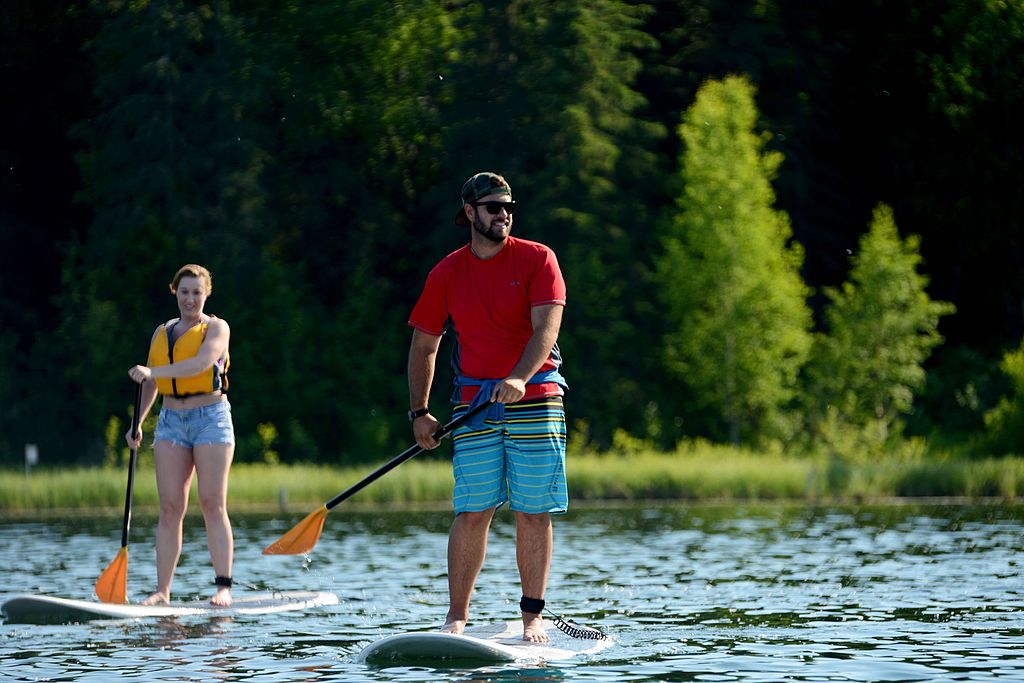 © Wikimedia.org/Airman Christopher Morales, CC0
© Wikimedia.org/Airman Christopher Morales, CC0
Padel (Spanish: Pádel) is a racket sport typically played in doubles on an enclosed court slightly smaller than a doubles tennis court. Scoring is the same as normal tennis, and the balls used are similar but with a little less pressure. The main differences are that the court has walls and the balls can be played off them in a similar way as in the game of squash and that solid, stringless bats are used. The height of the ball being served must be at or below the waist level. Padel is different from the sport known in Canada and the United States as paddle tennis. It is also not to be confused with platform tennis, a winter and summer sport typically played at country clubs in Canada and the US, with courts heated from below to eliminate snow and water. The court, rules, and styles of play are very different. (Source: Wikipedia.org, CC BY-SA)
 © Wikimedia.org/Laurix67, CC BY-SA
© Wikimedia.org/Laurix67, CC BY-SA
Paintball is a competitive team shooting sport in which players eliminate opponents from play by hitting them with spherical dye-filled gelatin capsules called paintballs that break upon impact. Paintballs are usually shot using low-energy air weapons called paintball markers that are powered by compressed air or carbon dioxide and were originally designed for remotely marking trees and cattle. The sport is played for recreation and is also played at a formal sporting level with organized competition that involves major tournaments, professional teams, and players. Paintball technology is also used by military forces, law enforcement, paramilitary, and security organizations to supplement military or other training. Games can be played on indoor or outdoor fields of varying sizes. A playing field may have natural or artificial terrain which players use for tactical cover. Game types and goals vary, but include capture the flag, elimination, defending or attacking a particular point or area, or capturing objects of interest hidden in the playing area. Depending on the variant played, games can last from minutes to hours, or even days in 'scenario play'. (Source: Wikipedia.org, CC BY-SA)
Parachuting, including also skydiving, is a method of transiting from a high point in the atmosphere to the surface of Earth with the aid of gravity, involving the control of speed during the descent using a parachute or parachutes. For human skydiving, it may involve a phase of more or less free-falling (the skydiving segment) which is a period when the parachute has not yet been deployed and the body gradually accelerates to terminal velocity. (Source: Wikipedia.org, CC BY-SA)
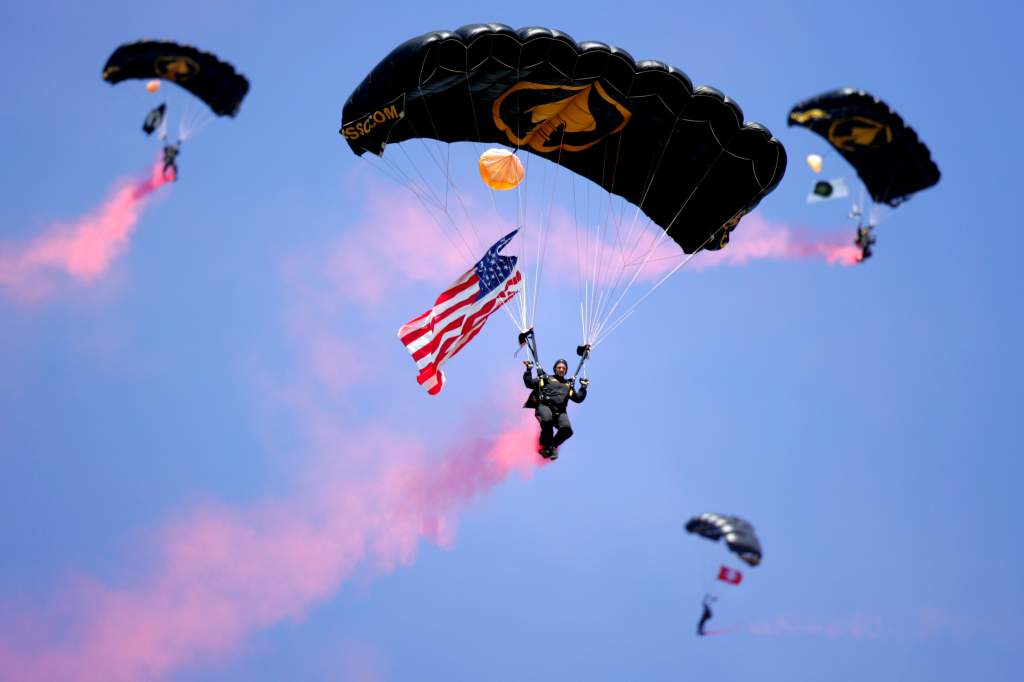 © Wikimedia.org/Department of Defense, CC0
© Wikimedia.org/Department of Defense, CC0
Paragliding is the recreational and competitive adventure sport of flying paragliders: lightweight, free-flying, foot-launched glider aircraft with no rigid primary structure. The pilot sits in a harness or lies supine in a cocoon-like 'pod' suspended below a fabric wing. Wing shape is maintained by the suspension lines, the pressure of air entering vents in the front of the wing, and the aerodynamic forces of the air flowing over the outside. Despite not using an engine, paraglider flights can last many hours and cover many hundreds of kilometres, though flights of one to two hours and covering some tens of kilometres are more the norm. By skillful exploitation of sources of lift, the pilot may gain height, often climbing to altitudes of a few thousand metres. (Source: Wikipedia.org, CC BY-SA)
Parallel bars are floor apparatus consisting of two wooden bars slightly over 11 feet (340 cm) long and positioned at roughly head height. Parallel bars are used in artistic gymnastics and also for physical therapy and home exercise. Gymnasts may optionally wear grips when performing a routine on the parallel bars, although this is uncommon. The apparatus consists of two parallel bars that are held parallel to, and elevated above, the floor by a metal supporting framework. The bars are composed of wood or other material, with an outer coating of wood. The vertical members of the supporting framework are adjustable so the height of the bars above the floor and distance between the bars can be set optimally for each gymnast. (Source: Wikipedia.org, CC BY-SA)
Parasailing, also known as parascending, paraskiing or parakiting, is a recreational kiting activity where a person is towed behind a vehicle while attached to a specially designed canopy wing that resembles a parachute, known as a parasail wing. The manned kite's moving anchor may be a car, truck, or boat. The harness attaches the occupant to the parasail, which is connected to the boat, or land vehicle, by the tow rope. The vehicle then drives off, carrying the parascender (or wing) and person into the air. If the boat is powerful enough, two or three people can parasail behind it at the same time. The parascender has little or no control over the parachute. The activity is primarily a fun ride, not to be confused with the sport of paragliding. There are commercial parasailing operations all over the world. Land-based parasailing has also been transformed into a competition sport in Europe. In land-based competition parasailing, the parasail is towed to maximum height behind a 4-wheel-drive vehicle. The driver then releases the tow line; the parasailer flies down to a target area in an accuracy competition. (Source: Wikipedia.org, CC BY-SA)
Parkour (French: [paʁkuʁ]) is an athletic training discipline or sport in which practitioners (called traceurs) attempt to get from point A to point B in the fastest and most efficient way possible, without assisting equipment and often while performing artistic-gymnastic maneuvers. With roots in military obstacle course training and martial arts, parkour includes running, climbing, swinging, vaulting, jumping, plyometrics, rolling, and quadrupedal movement—whatever is suitable for a given situation. Parkour is an activity that can be practiced alone or with others, and is usually carried out in urban spaces, though it can be done anywhere. It involves seeing one's environment in a new way, and envisioning the potential for navigating it by movement around, across, through, over and under its features. Although practitioners of Parkour often perform flips and other acrobatic movements, these are not considered a part of Parkour proper. (Source: Wikipedia.org, CC BY-SA)
Pétanque (French pronunciation: [petɑ̃k] , locally in Provence [peˈtãᵑkə]; Occitan: petanca, [peˈtaŋkɔ] , also Catalan: [pəˈtaŋkə] or [peˈtaŋka]) is a sport that falls into the category of boules sports, along with raffa, bocce, boule lyonnaise, lawn bowls, and crown green bowling. In all of these sports, players or teams play their boules/balls towards a target ball. In pétanque the objective is to score points by having boules closer to the target than the opponent after all boules have been thrown. This is achieved by throwing or rolling boules closer to the small target ball, officially called a jack (fr: cochonnet), or by hitting the opponents' boules away from the target, while standing inside a circle with both feet on the ground. The game is normally and best played on hard dirt or gravel. It can be played in public areas in parks or in dedicated facilities called boulodromes. (Source: Wikipedia.org, CC BY-SA)
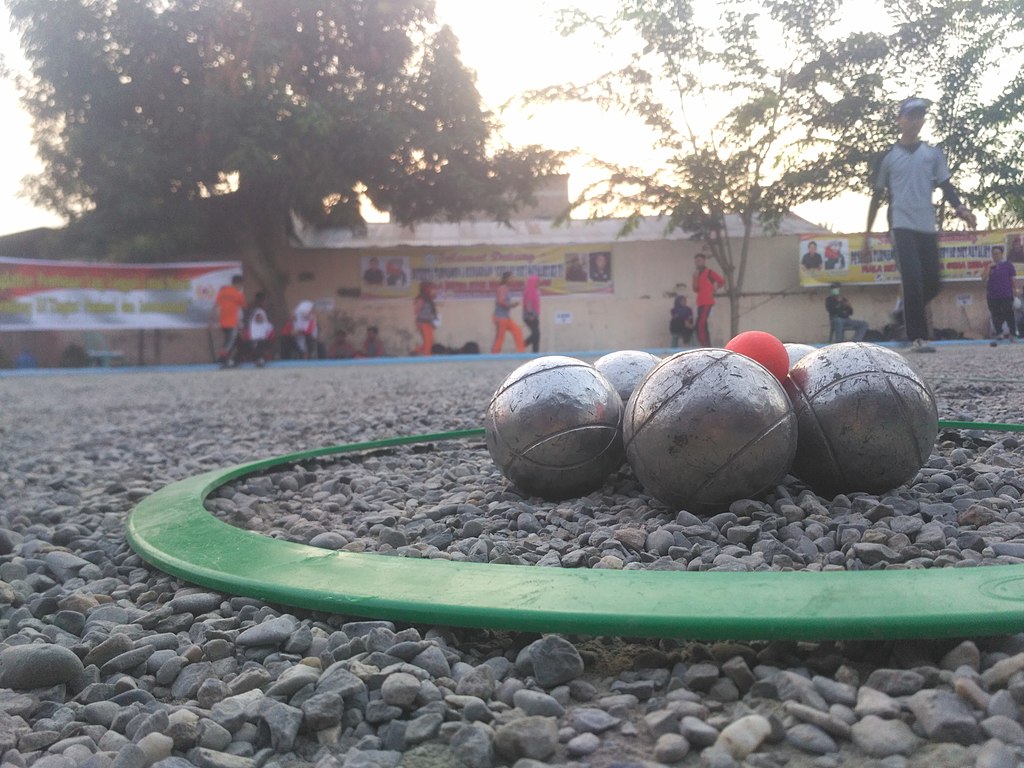 © Wikimedia.org/Suwanda2907, CC BY-SA
© Wikimedia.org/Suwanda2907, CC BY-SA
Pole climbing is ascending a pole which one can grip with his or her hands. The related activity of mast climbing describes ascending an object similar to a pole, but having a larger diameter which excludes gripping with the hands. In either case, it is normally assumed that climbers who view the activity as a gymnastic sport use only their bodies and limbs, without artificial aids. (Source: Wikipedia.org, CC BY-SA)
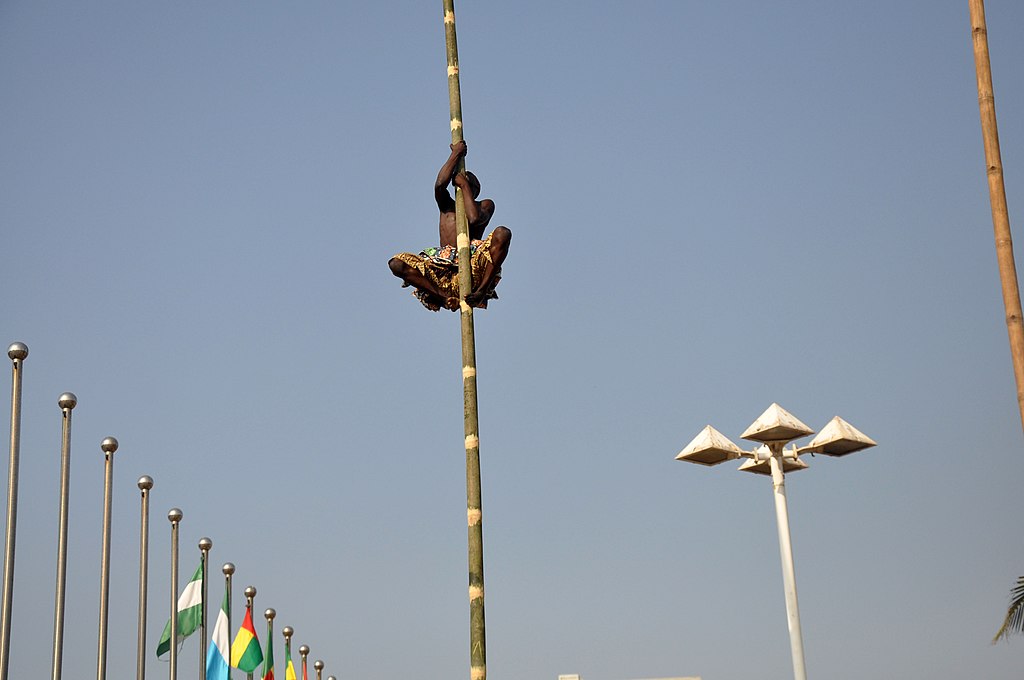 © Wikimedia.org/DEGAN Gabin, CC BY-SA
© Wikimedia.org/DEGAN Gabin, CC BY-SA
Pole dance combines dance and acrobatics centered on a vertical pole. This performance art form takes place not only in gentleman's clubs as erotic dance, but also as a mainstream form of fitness, practiced in gyms and dedicated dance studios. Pole dancing enthusiasts are of all ages; although many who perform this dance and acrobatic form are adults, that does not stop younger children from learning and performing in competitions. Amateur and professional pole dancing competitions are held in countries around the world. Pole dance requires significant muscular endurance, coordination, strength, flexibility, upper body and core stability, as well as sensuality. As such, proper instruction and rigorous training are necessary to attain proficiency. Today, pole performances by exotic dancers range from basic spins and striptease in more intimate clubs to athletic moves such as climbs and body inversions in the 'stage heavy' clubs of Las Vegas and Miami. Dancer Remy Redd at the King of Diamonds, for example, is famous for flipping herself upside down into a split and hanging from the ceiling. Since the mid-2000s, promoters of pole dance fitness competitions have tried to change peoples' perception of pole dance to include pole fitness as a non-sexual form of dance and acrobatics and are trying to move pole into the Olympics as pole sports. (Source: Wikipedia.org, CC BY-SA)
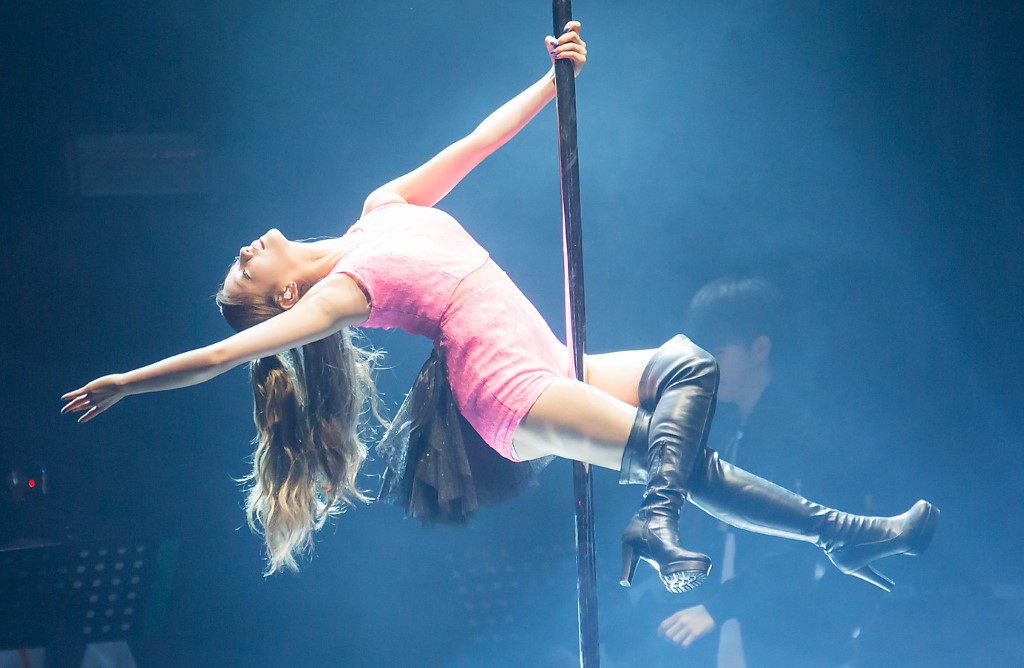 © Wikimedia.org/Unmilited, CC BY
© Wikimedia.org/Unmilited, CC BY
Pole vaulting, also known as pole jumping, is a track and field event in which an athlete uses a long and flexible pole, usually made from fiberglass or carbon fiber, as an aid to jump over a bar. Pole jumping competitions were known to the Mycenaean Greeks, Minoan Greeks and Celts[citation needed]. It has been a full medal event at the Olympic Games since 1896 for men and since 2000 for women. It is typically classified as one of the four major jumping events in athletics, alongside the high jump, long jump and triple jump. It is unusual among track and field sports in that it requires a significant amount of specialised equipment in order to participate, even at a basic level. A number of elite pole vaulters have had backgrounds in gymnastics, including world record breakers Yelena Isinbayeva and Brian Sternberg, reflecting the similar physical attributes required for the sports. Running speed, however, may be the most dominant factor. Physical attributes such as speed, agility and strength are essential to pole vaulting effectively, but technical skill is an equally if not more important element. The object of pole vaulting is to clear a bar or crossbar supported upon two uprights (standards) without knocking it down. (Source: Wikipedia.org, CC BY-SA)
Polo is a ball game played on horseback, a traditional field sport and one of the world's oldest known team sports. The game is played by two opposing teams with the objective of scoring using a long-handled wooden mallet to hit a small hard ball through the opposing team's goal. Each team has four mounted riders, and the game usually lasts one to two hours, divided into periods called chukkas or 'chukkers'. Arena polo is an indoor or semi-outdoor variant with similar rules, and is played with three riders per team. The playing field is smaller, enclosed and usually of compacted sand or fine aggregate, and often indoors. Arena polo has more maneuvering due to space limitations, and uses an air-inflated ball slightly larger than the hard solid ball used in field polo. Standard mallets are used, though slightly larger-head arena mallets are an option. (Source: Wikipedia.org, CC BY-SA)
The pommel horse is an artistic gymnastics apparatus. Traditionally, it is used by only male gymnasts. Originally made of a metal frame with a wooden body and a leather cover, the modern pommel horse has a metal body covered with foam rubber and leather, with plastic handles (or pommels). A typical pommel horse exercise involves both single leg and double leg workouts. Single leg skills are generally in the form of scissors. Double leg workout however, is the main staple of this event. The gymnast swings both legs in a circular motion (clockwise or counterclockwise depending on preference) and performs such skills on all parts of the apparatus. To make the exercise more challenging, gymnasts will often include variations on a typical circling skill by turning (moores and spindles), by straddling their legs (Flairs), placing one or both hands on the pommel or the leather, or moving up and down the horse placing their hands on the pommel and/or the leather (travelling). Routines end when the gymnast performs a dismount, either by swinging his body over the horse or going through a handstand to land on the mat. The pommel horse, its gymnastic elements, and various rules are all regulated by the Code of Points. (Source: Wikipedia.org, CC BY-SA)
Powerlifting is a strength sport that consists of three attempts at maximal weight on three lifts: squat, bench press, and deadlift. As in the sport of Olympic weightlifting, it involves the athlete attempting a maximal weight single-lift effort of a barbell loaded with weight plates. Powerlifting evolved from a sport known as 'odd lifts', which followed the same three-attempt format but used a wider variety of events, akin to strongman competition. Eventually odd lifts became standardized to the current three. In competition, lifts may be performed equipped or un-equipped (typically referred to as 'classic' or 'raw' lifting in the IPF specifically). Equipment in this context refers to a supportive bench shirt or squat/deadlift suit or briefs. In some federations, knee wraps are permitted in the equipped but not un-equipped division; in others, they may be used in both equipped and un-equipped lifting. Weight belts, knee sleeves, wrist wraps, and special footwear may also be used, but are not considered when distinguishing equipped from un-equipped lifting. (Source: Wikipedia.org, CC BY-SA)
 © Wikimedia.org/رادوینا, CC BY-SA
© Wikimedia.org/رادوینا, CC BY-SA
Rafting and whitewater rafting are recreational outdoor activities which use an inflatable raft to navigate a river or other body of water. This is often done on whitewater or different degrees of rough water. Dealing with risk is often a part of the experience. Rafting on certain sections of rivers is considered an extreme sport and can be fatal, while other sections are not so extreme or difficult. Rafting is also a competitive sport practiced around the world which culminates in a world rafting championship event between the participating nations. The International Rafting Federation, often referred to as the IRF, is the worldwide body which oversees all aspects of the sport. (Source: Wikipedia.org, CC BY-SA)
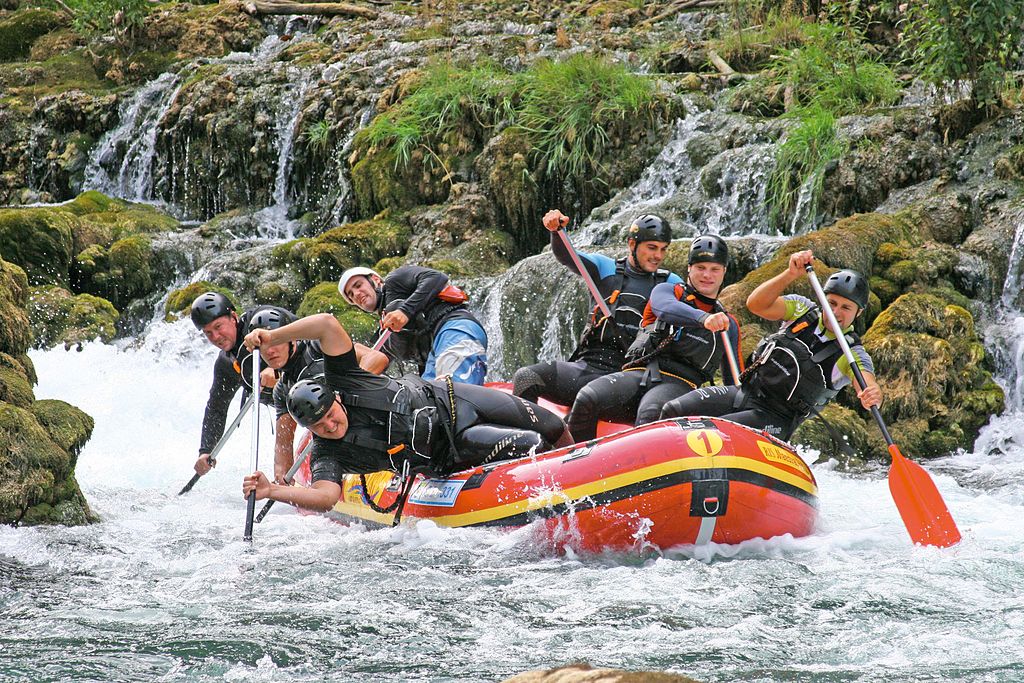 © Wikimedia.org/Nacionalni park Una, CC BY-SA
© Wikimedia.org/Nacionalni park Una, CC BY-SA

Help us promote traffic rules on the internet, together we can make the public road safer for everyone. Post a comment or share on social media!
look at the sign on the road to avoid accidents and horrible driving conditions
I received a 300$ ticket because I passed a police control of other cars/drivers on the right lane of a highway (the control was on the hard shoulder of the highway). Is it really true, that you have to change the lane in such cases? Thanks!
I am an American living in Italy. The Italian Drivers License theory test is the hardest test I have ever studied for and I am in my 70s have multiple degrees, multiple professional certifications. Have to take the Italian Drivers Theory test in Italian. No english. So many rules. More signs in small medieval Italian town I live in then in major US cities I have lived in. No Italian license no driving. No buying or renting a car. Test here was good, clean. Lots of tricky questions on many practice and real official tests. Thanks
Most problems are a result of higher than safe driving speeds. Please just slow down and be patient.
Question 121: Poor translation: Vehicles with polluted fluids prohibited Should be translated as: Vehicles with dangerous liquids prohibited
Question 83: Poor translation: Vehicles with polluted fluids prohibited Should be translated as: Vehicles with dangerous liquids prohibited
Want even more practice? Visit similar websites offering realistic practice driving knowledge tests. Visit us to see what sets our tests apart! https://dkttest.com/capital-territory/
Cool tool! And fun to check whether I remember the rules :) Two things I noticed: Warning for a crossroad side roads on the left and right. While technically that might be the correct translation, this sign tells you, that you are on the main road and have the right of way for the next crossroad and only the next crossroad. Usually (if no sign specifies otherwise) you have to give way to drivers coming from the right at every intersection, which can get a bit annoying in communal areas, so seeing this sign feels less like a warning and more like relief :). A Fahrradstraße is not a lane for cyclists but a street for cyclists, meaning the (whole!) street is intended predominantly for cyclists, who are then allowed to ride next to each other. Cars are allowed to drive there (unless another sign prohibits such), but have to adjust their speed to the cyclists. I believe they are not allowed to pass at all, even if the oncoming lane is empty.
this website is a simpy website i love this its fat and im in my mums basement rn help sui u r a mothr fker
More community